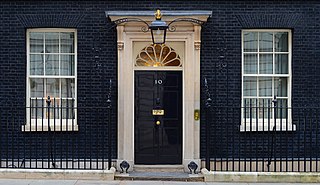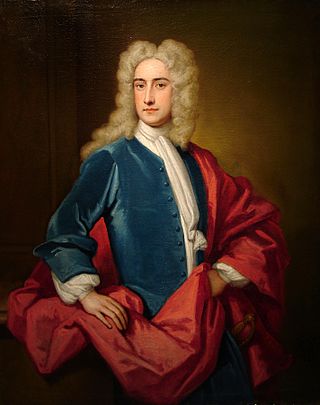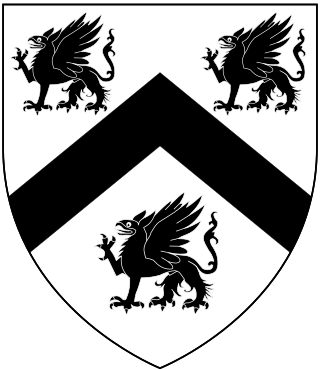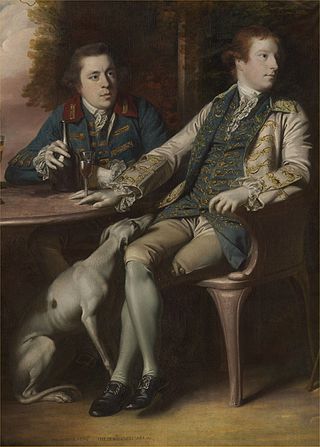Related Research Articles

The chancellor of the Exchequer, often abbreviated to chancellor, is a senior minister of the Crown within the Government of the United Kingdom, and head of His Majesty's Treasury. As one of the four Great Offices of State, the Chancellor is a high-ranking member of the British Cabinet.

Henry Pelham was a British Whig statesman who served as 3rd Prime Minister of Great Britain from 1743 until his death in 1754. He was the younger brother of Thomas Pelham-Holles, 1st Duke of Newcastle, who served in Pelham's government and succeeded him as prime minister. Pelham is generally considered to have been Britain's third prime minister, after Robert Walpole and the Earl of Wilmington.

10 Downing Street in London is the official residence and office of the prime minister of the United Kingdom.

In the civil service of the United Kingdom, His Majesty’s Exchequer, or just the Exchequer, is the accounting process of central government and the government's current account in the Consolidated Fund. It can be found used in various financial documents including the latest departmental and agency annual accounts.

Samuel Sandys, 1st Baron Sandys, was a British Whig politician who represented Worcester in the House of Commons from 1718 until 1743, when he was created Baron Sandys. He held numerous posts in the government of the United Kingdom, namely Chancellor of the Exchequer, Leader of the House of Commons, Cofferer of the Household and First Lord of Trade. He was also a justice in eyre.

William Lowndes was a British Whig politician who sat in the English and British House of Commons from 1695 to 1724. He was Secretary to the Treasury of Great Britain under King William III and Queen Anne,

Heneage Finch, 4th Earl of Aylesford, PC, FRS, FSA, styled Lord Guernsey between 1757 and 1777, was a British politician who sat in the House of Commons from 1772 to 1777 when he succeeded to a peerage. He was also a landscape artist.

Robert Walpole, 2nd Earl of Orford, KB, was a British peer and politician, styled Lord Walpole from 1723 to 1745.

Henry Fane was a British politician who sat in the House of Commons for 30 years between 1772 and 1802.
Sir Edward Walpole KB PC (Ire) was a British politician, and a younger son of Sir Robert Walpole, Prime Minister from 1721 to 1742.

John Scrope was a British lawyer and politician who sat in the House of Commons from 1722 to 1752.
Sir Richard Lane, a.k.a. Edward Lane, was an English barrister who practised mostly in the Court of Exchequer. He acted as defence counsel to the Earl of Strafford when the Earl was impeached and attainted, and also represented Archbishop Williams and eleven other bishops who were imprisoned in the Tower of London in 1642.

William Clayton, 1st Baron Sundon of Sundon Hall, Sundon, Bedfordshire was a British Treasury official and politician who sat in the House of Commons from 1716 to 1752.
Sir Edward Wardour was an English office holder and politician who sat in the House of Commons between 1621 and 1625.
The Record Commissions were a series of six Royal Commissions of Great Britain and the United Kingdom which sat between 1800 and 1837 to inquire into the custody and public accessibility of the state archives. The Commissioners' work paved the way for the establishment of the Public Record Office in 1838. The Commissioners were also responsible for publishing various historical records, including the Statutes of the Realm to 1714 and the Acts of Parliament of Scotland to 1707, as well as a number of important medieval records.

The Burdett Coutts Memorial Sundial is a structure built in the churchyard of Old St Pancras, London, in 1877–79, at the behest of Baroness Burdett-Coutts. The former churchyard included the burial ground for St Giles-in-the-Fields, where many Catholics and French émigrés were buried. The graveyard closed to burials in 1850, but some graves were disturbed by a cutting of the Midland Railway in 1865 as part of the works to construct its terminus at St Pancras railway station. The churchyard was acquired by the parish authorities in 1875 and reopened as a public park in June 1877. The high Victorian Gothic memorial was built from 1877 and unveiled in 1879. The obelisk acts as a memorial to people buried near the church whose graves were disturbed; the names of over 70 of them are listed on the memorial, including the Chevalier d'Éon, Sir John Soane, John Flaxman, Sir John Gurney, and James Leoni.
The Clerk of the Pipe was a post in the Pipe Office of the English Exchequer and its successors. The incumbent was responsible for the pipe rolls on which the government income and expenditure was recorded as credits and debits.
Henry Pelham was an English Member of Parliament. A younger son of Sir John Pelham, 3rd Baronet, he was returned for two Parliamentary constituencies in Sussex, where the family held considerable influence, for most of the time between 1690 and 1702. Appointed to the sinecure office of Clerk of the Pells in 1698, Pelham was a reliable Whig and Court-supporting placeman.
References
- ↑ Gentleman's Magazine, op.cit.
- 1 2 National Archives, notes on "Category E" Records of the Exchequer, and its related bodies, with those of the Office of First Fruits and Tenths, and the Court of Augmentations
- ↑ Gentleman's Magazine, vol.5, 1836, pp.18-22 . A dubious etymology is provided in the same article thus: "Roll and pell mean the same thing, the latter word Petlh? indicates the substance upon which the entries were made, the former, Rotuli, the form of the Pell when not in use"
- ↑ Cassell's Latin Dictionary
- ↑ "UVEDALE (EVEDALE, UDALL, WOODALL), John (by 1482-1549), of Marrick, Yorks". History of Parliament. Retrieved 11 May 2017.
- ↑ "COCKERELL, Edmund (by 1510-59/60), of London". History of Parliament. Retrieved 11 May 2017.
- ↑ "HARE, Robert (c.1531-1611), of Bruisyard, Suff. and London". History of Parliament. Retrieved 11 May 2017.
- ↑ "WARDOUR, Chidiock (1542-1611), of Plaitford, Hants and St. Martin-in-the-Fields, London". History of Parliament. Retrieved 11 May 2017.
- 1 2 3 "WARDOUR, Sir Edward (1578-1646), of Chiswick House, Chiswick, Mdx. and St. Martin-in-the-Fields, Westminster". History of Parliament. Retrieved 11 May 2017.
- 1 2 "WARDOUR, William (1686-1746), of Whitney Court, Herefs". History of Parliament. Retrieved 11 May 2017.
- ↑ Watson, Paula (2002). "PELHAM, Henry (c.1661-1721), of Stanmer, Suss.". In Hayton, David; Cruickshanks, Eveline; Handley, Stuart (eds.). The House of Commons 1690-1715. The History of Parliament Trust.
- ↑ "WALPOLE, Hon. Edward (1706-84), of Frogmore, Berks". History of Parliament. Retrieved 11 May 2017.
- ↑ "BARRE, Isaac (1726-1802), of Manchester Buildings, Westminster". History of Parliament. Retrieved 11 May 2017.
- ↑ "Landed families of Britain and Ireland: (44) Addington of up Ottery and Erleigh Court, Viscounts Sidmouth". 2 June 2013.
- ↑ "ELLIS, Henry (1788-1855)". History of Parliament. Retrieved 11 May 2017.
